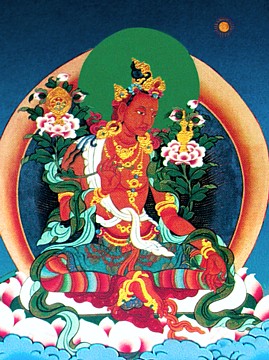Maitreya: Difference between revisions
Jump to navigation
Jump to search
No edit summary |
mNo edit summary |
||
| Line 1: | Line 1: | ||
[[Image:Maitreya.jpg|frame|Maitreya]] | [[Image:Maitreya.jpg|frame|Maitreya]] | ||
'''Maitreya''' (Skt.; Tib. ''Jampa''; [[Wyl.]] ''byams pa'') or '''Maitreyanatha''' (Skt. ''Maitreynātha''; Tib. ''Jampé Gönpo''; Wyl. ''byams pa'i mgon po'') is the [[bodhisattva]] who will be the next [[buddha]] after [[Shakyamuni Buddha]]. For now he resides in [[Tushita]]. He transmitted teachings to [[Asanga]], who transcribed them as the ‘[[Five Treatises of Maitreya]]’. As one of the [[eight great bodhisattvas]], he is sometimes depicted as whitish-yellow in colour and holding an orange bush which dispels the fever of the [[destructive emotions]]. | '''Maitreya''' (Skt.; Tib. བྱམས་པ་, ''Jampa''; [[Wyl.]] ''byams pa'') or '''Maitreyanatha''' (Skt. ''Maitreynātha''; Tib. ''Jampé Gönpo''; Tib. བྱམས་པ་མགོན་པོ་, Wyl. ''byams pa'i mgon po'') is the [[bodhisattva]] who will be the next [[buddha]] after [[Shakyamuni Buddha]]. For now he resides in [[Tushita]]. He transmitted teachings to [[Asanga]], who transcribed them as the ‘[[Five Treatises of Maitreya]]’. As one of the [[eight great bodhisattvas]], he is sometimes depicted as whitish-yellow in colour and holding an orange bush which dispels the fever of the [[destructive emotions]]. | ||
==Five Treatises== | ==Five Treatises== | ||
Maitreya transmitted the root teachings to [[Asanga]]. Among the five, four are classed as [[shastra]]s (commentaries) proper, and one falls into the class of oral instructions. The four that are shastras are extensive are: | Maitreya transmitted the root teachings to [[Asanga]]. Among the five, four are classed as [[shastra]]s (commentaries) proper, and one falls into the class of oral instructions. The four that are shastras are extensive are: | ||
#[[The Ornament of Clear Realization]] (Skt. ''Abhisamayālaṃkāra''; Wyl. ''mngon par rtogs pa'i rgyan''). | #[[The Ornament of Clear Realization]] (Skt. ''Abhisamayālaṃkāra''; Tib. <big>མངོན་རྟོགས་པའི་རྒྱན་</big>, Wyl. ''mngon par rtogs pa'i rgyan''). | ||
#[[The Ornament of the Mahayana Sutras]] (Skt. ''Māhayānasūtrālaṃkāra''; ''theg pa chen po'i mdo sde rgyan''). | #[[The Ornament of the Mahayana Sutras]] (Skt. ''Māhayānasūtrālaṃkāra''; Tib. <big>ཐེག་པ་ཆེན་པོའི་མདོ་སྡེ་རྒྱན་</big>, ''theg pa chen po'i mdo sde rgyan''). | ||
#[[Distinguishing the Middle from the Extremes]] (Skt. ''Madhyāntavibhāga''; ''dbus dang mtha' rnam par 'byed pa''). | #[[Distinguishing the Middle from the Extremes]] (Skt. ''Madhyāntavibhāga''; Tib. <big>དབུས་དང་མཐའ་རྣམ་པར་འབྱེད་པ་</big>, ''dbus dang mtha' rnam par 'byed pa''). | ||
#[[Distinguishing Dharma and Dharmata]] (Skt. ''Dharma-dharmatā-vibhāga; ''chos dang chos nyid rnam par 'byed pa'') is very brief and direct in its presentation and is included within the class of oral instructions. | #[[Distinguishing Dharma and Dharmata]] (Skt. ''Dharma-dharmatā-vibhāga''; Tib. <big>ཆོས་དང་ཆོས་ཉིད་</big>, ''chos dang chos nyid rnam par 'byed pa'') is very brief and direct in its presentation and is included within the class of oral instructions. | ||
#[[The Sublime Continuum]] (Skt. ''Uttaratantra Śāstra''; [[Wyl.]] ''rgyud bla ma''). | #[[The Sublime Continuum]] (Skt. ''Uttaratantra Śāstra''; Tib. <big>རྒྱུད་བླ་མ་</big>, [[Wyl.]] ''rgyud bla ma''). | ||
==Further Reading== | ==Further Reading== | ||
Revision as of 13:03, 27 January 2011

Maitreya (Skt.; Tib. བྱམས་པ་, Jampa; Wyl. byams pa) or Maitreyanatha (Skt. Maitreynātha; Tib. Jampé Gönpo; Tib. བྱམས་པ་མགོན་པོ་, Wyl. byams pa'i mgon po) is the bodhisattva who will be the next buddha after Shakyamuni Buddha. For now he resides in Tushita. He transmitted teachings to Asanga, who transcribed them as the ‘Five Treatises of Maitreya’. As one of the eight great bodhisattvas, he is sometimes depicted as whitish-yellow in colour and holding an orange bush which dispels the fever of the destructive emotions.
Five Treatises
Maitreya transmitted the root teachings to Asanga. Among the five, four are classed as shastras (commentaries) proper, and one falls into the class of oral instructions. The four that are shastras are extensive are:
- The Ornament of Clear Realization (Skt. Abhisamayālaṃkāra; Tib. མངོན་རྟོགས་པའི་རྒྱན་, Wyl. mngon par rtogs pa'i rgyan).
- The Ornament of the Mahayana Sutras (Skt. Māhayānasūtrālaṃkāra; Tib. ཐེག་པ་ཆེན་པོའི་མདོ་སྡེ་རྒྱན་, theg pa chen po'i mdo sde rgyan).
- Distinguishing the Middle from the Extremes (Skt. Madhyāntavibhāga; Tib. དབུས་དང་མཐའ་རྣམ་པར་འབྱེད་པ་, dbus dang mtha' rnam par 'byed pa).
- Distinguishing Dharma and Dharmata (Skt. Dharma-dharmatā-vibhāga; Tib. ཆོས་དང་ཆོས་ཉིད་, chos dang chos nyid rnam par 'byed pa) is very brief and direct in its presentation and is included within the class of oral instructions.
- The Sublime Continuum (Skt. Uttaratantra Śāstra; Tib. རྒྱུད་བླ་མ་, Wyl. rgyud bla ma).
Further Reading
- The Fortunate Aeon: How the Thousand Buddhas Became Enlightened (Berkeley: Dharma Publishing, 1986), volume 2, page 521-523.
- Jamgön Mipham, A Garland of Jewels, (trans. by Lama Yeshe Gyamtso), Woodstock: KTD Publications, 2008
- Sogyal Rinpoche, The Tibetan Book of Living and Dying, pages 125-126.